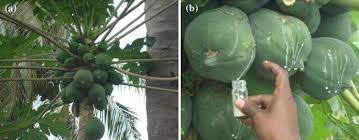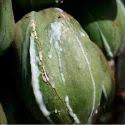PawPaw/Papaya Latex is a creamy, whitish to pale yellow substance that resembles milk in its consistency. It is sticky and thick, with a distinct odor that is often described as unpleasant or pungent. The latex contains a variety of biologically active compounds, including enzymes, proteases, and secondary metabolites.
Traditionally, the latex has been used in some cultures for its potential medicinal properties. It is believed to have digestive and anti-parasitic properties and has been used to treat digestive issues, such as constipation and indigestion.
In some instances, the latex is used in cooking as a meat tenderizer or in folk remedies for digestive ailments. However, its use in cooking is not as common due to its strong taste and potential for causing allergies or irritation in some individuals.
Papaya latex is particularly rich in enzymes, with one of the most notable being papain. Papain is a proteolytic enzyme that can break down proteins, which is why it has been used historically as a meat tenderizer.
It is also used in various industries, including the food, pharmaceutical, and cosmetic sectors, for its protein-digesting properties.
While the enzymes present in pawpaw/papaya latex can have beneficial applications, the latex itself can be irritating to the skin and mucous membranes. Direct contact with the latex may cause allergic reactions or skin irritation in some individuals.
In addition to its traditional uses, papaya latex and its enzyme extracts are used in various commercial products, such as meat tenderizers, digestive supplements, and skincare products.
The Economic Importance and Uses of PawPaw/Papaya Latex

Papaya latex, also known as papain latex, is a milky substance extracted from the unripe fruit of the papaya (Carica papaya) tree. It contains enzymes like papain, chymopapain, and protease, which have various industrial and commercial applications due to their proteolytic (protein-digesting) properties.
Here are some economic importance and uses of papaya latex:
1. Food Industry: Papaya latex is used as a meat tenderizer due to its proteolytic enzymes. It breaks down the proteins in meat, making it more tender. It’s commonly used in marinating and cooking meats. For example, papaya latex can be applied to tougher cuts of meat to help improve their texture and flavor.
2. Brewing Industry: The enzymes in papaya latex can be used in the brewing process to break down proteins in malted grains. This can enhance the fermentation process and improve the clarity and stability of the final beer product.
3. Textile Industry: Papaya latex is utilized in the textile industry for degumming and softening natural fibers like silk and wool. The enzymes help remove the gum and other impurities from the fibers, improving their quality and making them suitable for further processing.
4. Pharmaceutical Industry: Papaya latex has medicinal properties and is used in the pharmaceutical industry. The enzymes in the latex have potential applications in wound healing, as they can help remove dead tissue and promote the growth of healthy tissue. Papaya latex-based creams and ointments may be used for this purpose.
5. Cosmetic Industry: The exfoliating and proteolytic properties of papaya latex make it a popular ingredient in cosmetic products like facial masks, scrubs, and creams. It helps remove dead skin cells and promotes a smoother complexion.
6. Biotechnology and Enzyme Production: The enzymes in papaya latex, particularly papain, have a wide range of applications in biotechnology. They are used in research laboratories for protein digestion and analysis. Papain is also used for enzyme production, such as in the production of recombinant proteins.
7. Agriculture: In agriculture, papaya latex can be used as a natural pesticide. The proteolytic enzymes can break down the exoskeletons of insect pests, helping to control their populations. However, this use is controversial due to potential environmental and safety concerns.
8. Biofuel Production: Papaya latex enzymes can be employed in biofuel production, especially in the conversion of lignocellulosic biomass into biofuels. The enzymes help break down complex plant materials into simpler sugars, which can then be fermented into biofuels.
9. Medicinal and Digestive Aid: Papaya latex, specifically the enzyme papain, is used as a digestive aid in some traditional medicine practices. It is believed to help improve digestion by breaking down proteins in the stomach, thus aiding in nutrient absorption. Papaya enzyme supplements are available for this purpose.
5. Skin Care and Wound Healing: Papaya latex is often used in traditional medicine for its potential wound-healing properties. It may be applied topically to wounds to promote healing and reduce inflammation. Some commercial wound-care products contain papaya latex or its derivatives.
6. Bioactive Compounds and Research: Researchers study papaya latex for its bioactive compounds and potential health benefits. These compounds include not only enzymes like papain but also other bioactive compounds like alkaloids, flavonoids, and polyphenols.
7. Horticulture and Plant Propagation: Papaya latex is sometimes used as a natural rooting hormone for plant cuttings in horticulture. The enzymes present in the latex can stimulate root development, aiding in the successful propagation of various plant species.
8. Leather Industry: The proteolytic enzymes in papaya latex can be used in the leather industry for the dehairing and softening of animal hides. This process helps prepare the hides for further processing and tanning.
9. Cheese Making: Papaya latex enzymes, particularly chymopapain, have been explored for their potential use in cheese making. These enzymes can help curdle milk and aid in the coagulation process, which is essential in certain types of cheese production.
Read Also: PawPaw/Papaya Skin: Economic Importance, Uses and By-Products
10. Potential Anti-Cancer Properties: Some studies suggest that papaya latex may possess anti-cancer properties due to the presence of bioactive compounds. These compounds could potentially inhibit the growth of cancer cells and contribute to the development of anti-cancer therapies.
11. Allergies and Sensitivities: Papaya latex can cause allergic reactions in some individuals, ranging from mild skin irritation to more severe allergic responses. Proper handling and protective measures should be taken when working with papaya latex.
12. Sustainable Harvesting: Overexploitation of papaya trees for their latex can have negative ecological impacts. Sustainable harvesting practices and cultivation methods are crucial to ensure the long-term availability of papaya latex and its associated benefits.
13. Regulation and Safety: The use of papaya latex in various industries must adhere to safety and regulatory standards to prevent adverse effects on human health and the environment.
14. Cultural and Ethical Considerations: In some regions, papaya trees hold cultural significance and play a role in local diets and traditional practices. Balancing economic uses with cultural and ethical considerations is important for responsible utilization.
The Products and By-products That Can Be Derived From PawPaw/Papaya Latex

Papaya latex has been used traditionally for various purposes, including as a meat tenderizer, digestive aid, and in folk medicine. However, it’s important to note that papaya latex can be toxic in large quantities and may cause skin irritation, so handling it should be done with care.
Here are some potential products and by-products that can be derived from papaya latex, along with explanations and examples:
1. Papain Enzyme Extract: Papain is a proteolytic enzyme found in papaya latex. It has various applications in the food, pharmaceutical, and cosmetic industries as a meat tenderizer, digestive aid, and exfoliating agent, respectively.
Papain is commonly used as a meat tenderizer to break down tough meat fibers. It is also used in some toothpaste formulations for its teeth-whitening and cleaning properties.
2. Papaya Latex Fiber: The latex can be used to produce fibers that could potentially have applications in textiles and clothing.
While not as common as other fibers, papaya latex fibers have been explored for their potential use in making durable and biodegradable textiles.
3. Natural Rubber Substitute: Papaya latex contains latex compounds that could potentially serve as a substitute for natural rubber in certain applications.
Some studies have investigated the possibility of using papaya latex as a source of natural rubber, especially in regions where rubber trees are not prevalent.
4. Biopesticides: The bioactive compounds in papaya latex, including alkaloids and enzymes, can be used to create natural insecticides and pesticides.
Papaya latex extracts have been studied for their potential use as biopesticides to control agricultural pests and insects.
5. Digestive Enzyme Supplements: Papain, one of the enzymes found in papaya latex, can be used as a digestive enzyme supplement to aid in digestion and alleviate digestive discomfort.
Digestive enzyme supplements containing papain are available over the counter to help people with digestive issues.
6. Cosmetic and Skincare Products: Papaya latex extracts can be used in cosmetic and skincare products for their exfoliating, brightening, and anti-aging properties.
Papaya latex extracts are commonly used in exfoliating scrubs and facial masks to help remove dead skin cells and promote a more radiant complexion.
Read Also: How to Grow Paw-Paw (papayas): Beginners Business Guide
7. Anti-inflammatory Agents: Certain compounds in papaya latex, such as chymopapain, exhibit anti-inflammatory properties and may be used in pharmaceutical products.
Chymopapain, derived from papaya latex, has been used in the treatment of herniated discs to reduce inflammation and alleviate pain.
8. Wound Healing and Tissue Regeneration: Some studies suggest that papaya latex extracts could have potential applications in wound healing and tissue regeneration due to their proteolytic and antimicrobial properties.
Papaya latex preparations have been investigated for their ability to promote wound healing and tissue repair.
9. Medicinal Extracts: Papaya latex contains various bioactive compounds that have been studied for their potential medicinal properties, such as anti-cancer, anti-malarial, and anti-viral activities.
Research has shown that certain compounds in papaya latex, such as carpaine and benzyl isothiocyanate, exhibit anti-cancer properties and may have therapeutic potential.
10. Adhesives: The latex contains sticky compounds that can be used as natural adhesives or glues in various applications.
In some traditional practices, papaya latex has been used as a natural adhesive for sealing wounds or attaching items together.
11. Biodegradable Plastics: The latex compounds can potentially be used as a source for producing biodegradable plastics and polymers.
Research is ongoing to explore the use of papaya latex as a sustainable source for producing eco-friendly plastics.
12. Fruit Flavored Extracts: Papaya latex can be processed to extract flavor compounds that can be used in the food and beverage industry.
Papaya-flavored extracts derived from papaya latex can be used to add natural flavor to confectionery, beverages, and other food products.
13. Pharmaceutical Excipients: Papaya latex extracts can be used as excipients (inactive ingredients) in pharmaceutical formulations to improve drug stability and delivery.
Papaya latex extracts may be used as binders, disintegrants, or emulsifiers in tablet or capsule formulations.
14. Insect Repellents: Certain compounds in papaya latex may have insect-repelling properties, making them potentially useful in insect repellent formulations.
Papaya latex extracts could be incorporated into natural insect repellents to deter insects from approaching humans or crops.
15. Plant Growth Promoters: Papaya latex contains bioactive compounds that may have beneficial effects on plant growth and development.
Diluted papaya latex extracts might be used as a natural plant growth promoter to enhance crop yields and improve plant health.
16. Biological Research Tools: The enzymes and compounds present in papaya latex can be used as tools in various biological and biochemical research experiments.
Papain, one of the enzymes in papaya latex, is commonly used in laboratories for protein digestion and purification.
It is important to emphasize that while these are potential applications of papaya latex and its derivatives, the development of each application requires thorough research, safety assessments, and often regulatory approval.
The handling and processing of papaya latex should always be carried out with proper precautions due to its potential toxic and irritant properties. As research and technology advance, new applications for papaya latex may continue to emerge.
In conclusion, papaya latex offers a diverse range of economic uses and potential benefits across various industries. However, careful management, research, and adherence to safety protocols are essential to maximize its positive impacts while minimizing potential risks.
Read Also: What Can Be Recycled: A Guide to Reusing and Recycling
